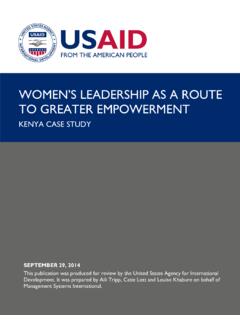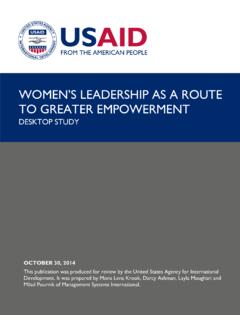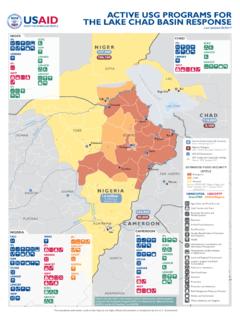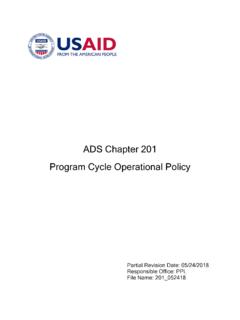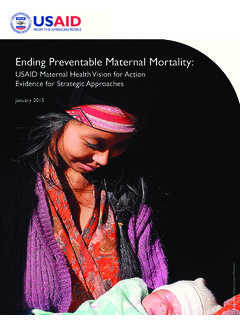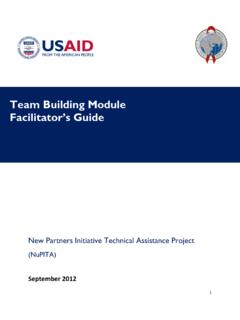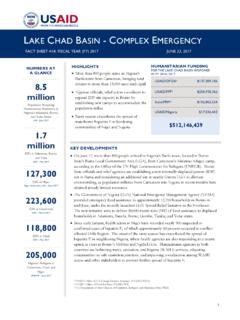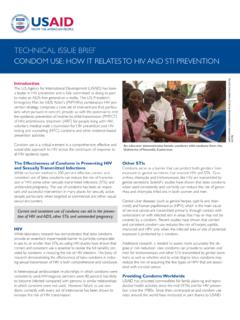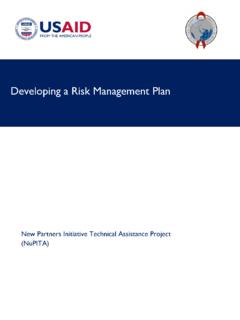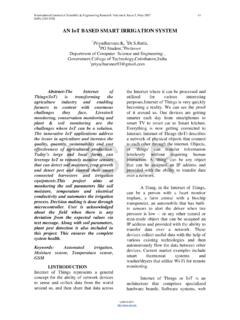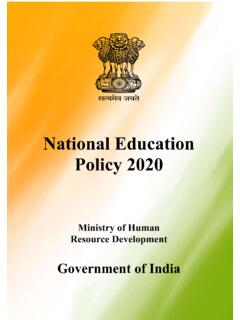Transcription of DIGITAL STRATEGY
1 DIGITALSTRATEGY2020 2024 Photos on cover, (clockwise): ; Jack Gordon, USAID; Riaz Jahanpour, USAIDT oday, many of us take for granted our access to DIGITAL technology like smartphones and the Internet. They have become an integral part of our day-to-day lives and increasingly our default way of communicating, learning, and doing business. We should remember, however, that four billion people in developing countries still do not have access to the Internet, including a staggering 93 percent of households in the least-developed nations. Further exacerbating the situation, the gender DIGITAL divide continues to grow. Women are, on average, 14 percent less likely to own mobile phones than their male counterparts, and 43 percent less likely to engage technology s profound potential is tempered by the looming threats posed by authoritarian governments and malevolent actors who use DIGITAL tools to suppress political dissent and other individual freedoms while also limiting competition in the marketplace.
2 Across these two, at times incongruent, DIGITAL worlds, we must be steadfast in ensuring we do not leave behind the poor and marginalized. I am pleased to share with you the first Agency for International Development (USAID) DIGITAL STRATEGY , an Agency-wide vision for the responsible use of DIGITAL technology in development and humanitarian work. Building on decades of leadership in DIGITAL development, the STRATEGY outlines USAID s deliberate and holistic commitment to strengthen open, inclusive, and secure DIGITAL ecosystems in each country in which we work. These DIGITAL ecosystems are transforming how people worldwide gain access to information, goods, services, and opportunities; in today s world, a country cannot achieve self-reliance without them. The field of international development is not immune to the DIGITAL changes around us, and, as the premier development donor, we at USAID have a responsibility to taxpayers, to the communities we serve, and to ourselves to meet the challenges and seize the opportunities of the DIGITAL age.
3 This is central to USAID s mission to end the need for foreign assistance, but we cannot do it alone. We ask our partners and colleagues around the world to engage with us. I am confident that, through collaboration, ingenuity, shared values, and collective experience, the future of our DIGITAL world will be bright for Mark Andrew Green USAID AdministratorADMINISTRATOR S MESSAGEACKNOWLEDGEMENTSThe USAID DIGITAL STRATEGY is the result of significant contributions from across USAID and our partner community, including implementing organizations, governments, donors, civil society and the private sector. The STRATEGY would not have been possible without the dedicated leadership and support of Harry Bader, Acting Executive Director for the Global Development Lab, and Gloria Steele, Acting Assistant Administrator of the Bureau for Asia. The STRATEGY benefited from the guidance of Christopher Burns, the Director for the Center for DIGITAL Development in the Global Development Lab, and was the product of contributions made by over 130 colleagues from 19 bureaus and independent offices and 25 missions, who participated in the STRATEGY s development as members of the Working Group and Advisory Group.
4 The STRATEGY was written by a Drafting Team, led by Aubra Anthony ( Global Development Lab), with drafters from multiple bureaus: Adam Kaplan and Amy Malessa in the Bureau for Democracy, Conflict, and Humanitarian Assistance; Paul Fekete in the Bureau for Economic Growth, Education, and Environment; Adele Waugaman in the Bureau for Global Health; Irena Sargsyan from the Bureau for Policy, Planning, and Learning; and John O Bryan in the Global Development Lab. TABLE OF CONTENTS 1 CONTENTS01 EXECUTIVE SUMMARY ..302 DEVELOPMENT IN A DIGITAL AGE ..6 USAID s Vision ..7 Realizing Benefits: DIGITAL as an Enabling Force For Development ..10 Accounting for Risks: A Need for Safeguarding in DIGITAL Ecosystems ..13 Why DIGITAL Requires Us to Refine Our Approach to Development ..2003 GUIDING PRACTICES ..2204 STRATEGIC FRAMEWORK: FOSTERING AN INCLUSIVE DIGITAL FUTURE ..25 Strategic Objective Strategic Objective CONCLUSION.
5 3006 ANNEXES ..31 Annex I: Detailed Strategic Framework ..32 Annex II: USAID DIGITAL STRATEGY Implementation Initiatives ..41 Annex III: Glossary ..48 Annex IV: Principles for DIGITAL Development ..51 ENDNOTES ..522 STRATEGIC FRAMEWORK: FOSTERING AN INCLUSIVE DIGITAL FUTUREP hoto: Riaz Jahanpour, USAID EXECUTIVE SUMMARY 3 EXECUTIVE SUMMARYC ountries around the world are in the midst of a historic DIGITAL transition. The rapid development and adoption of DIGITAL technology are transforming industries, governments, economies, and societies. DIGITAL ecosystems the stakeholders, systems, and enabling environments that together empower people and communities to use DIGITAL technology to gain access to services, engage with each other, or pursue economic opportunities hold immense potential to help people live freer, healthier, more prosperous lives. These ecosystems can help drive economic empowerment and financial inclusion, advance national security, support accountability and transparency in governance, introduce new and innovative health solutions, and make development and humanitarian assistance more efficient and effective.
6 DIGITAL transformation comes with the risk of increasing inequality, repression, and instability. Malign actors capture DIGITAL infrastructure to advance divisive messaging, crime, and illicit finance. Despite the global prevalence of mobile phones and the Internet, the reality in many communities does not yet reflect the potential of a DIGITAL ecosystem that drives sustainable and equitable growth. Vulnerable or marginalized groups often find themselves excluded from the DIGITAL ecosystem because of inadequate infrastructure or a lack of affordable or relevant products, services, and content; or because political, social, environmental, or economic factors inhibit equitable uptake. Now more than ever, as the global development community works to deliver life-saving assistance and relay crucial information in the face of the pandemic of COVID-19, the role of DIGITAL technology is undeniable. Teachers deliver lessons remotely to homebound classes; health care workers diagnose patients via telemedicine to minimize their risk of exposure; and people worldwide seek out online information about the pandemic s impact on their lives and livelihoods.
7 Across all of these activities, DIGITAL technology is what allows us to remain connected even while physical distancing requires us to be apart. It is more important than ever for USAID to help communities be resilient in the face of threats like this global pandemic, by ensuring all countries have robust DIGITAL ecosystems that are open, inclusive, secure, and of benefit to light of this, The Agency for International Development (USAID) DIGITAL STRATEGY (2020-2024) will position the Agency to advance our mission to end the need for foreign assistance through digitally supported programming that fosters the Journey to Self-Reliance in our partner countries and maximizes the benefits, while managing the risks that DIGITAL technology introduces into the lives of the communities we serve. DIGITAL TECHNOLOGYIn this STRATEGY , we use the term DIGITAL technology not only to describe a type of technology but also to refer to the platforms, processes, and range of technologies that underpin modern information and communications technologies (ICT), including the Internet and mobile-phone platforms, as well as advanced data infrastructure and analytic EXECUTIVE SUMMARYGOAL OF THE USAID DIGITAL STRATEGY : To achieve and sustain open, secure, and inclusive DIGITAL ecosystems that contribute to broad-based, measurable development and humanitarian-assistance outcomes and increase self-reliance in emerging market DIGITAL STRATEGY centers around two core, mutually reinforcing objectives: Improve measurable development and humanitarian assistance outcomes through the responsible use of DIGITAL technology in USAID s programming; and Strengthen the openness, inclusiveness, and security of country-level DIGITAL ecosystems.
8 These objectives, and USAID s approach to achieving them, support the goals and principles outlined in key policy documents, including the USAID Policy Framework; the Department of State-USAID Joint Strategic Plan; and the National Cyber, National Security, and Counterterrorism Strategies. USAID will work to improve the efficiency and effectiveness of foreign assistance through the consistent and responsible use of DIGITAL technology in our development and humanitarian programming. Through our programmatic investments, USAID will work to strengthen the critical components of DIGITAL ecosystems that enable sustainable growth in a DIGITAL age: a sound enabling environment and policy commitment; robust and resilient DIGITAL infrastructure; capable DIGITAL service providers and workforce; and, ultimately, empowered end-users of digitally enabled we become a more responsive, field-oriented Agency that fosters self-reliance around the globe, USAID must consider the capacities and commitment in the countries where we work in order to capitalize on the opportunities and address the risks inherent in DIGITAL systems.
9 USAID s investments in country-level DIGITAL infrastructure and systems must lead to sustainable ownership and management by local governments, citizens, and the private sector. Where capacity is lacking, we can build our partners technical capabilities to oversee these systems and responsibly leverage the data they produce to inform their own decisions. Where commitment is low, USAID can empower and equip civil society and the private sector to navigate complex and rapidly evolving DIGITAL ecosystems and hold governments accountable. For communities to achieve self-reliance in the DIGITAL age, open, inclusive, and secure DIGITAL ecosystems that preserve and protect the rights and agency of individuals are critical. The proper use, understanding, and application of technology is a development will take a multipronged approach, implemented under the leadership and authorities granted to various Operating Units (OUs) within the Agency to achieve the objectives of the DIGITAL STRATEGY .
10 Close consultation and collaboration with governments, civil society, the private sector, and local communities in countries where we work will guide this approach. We will work to develop the tools and resources necessary to provide effective development and humanitarian assistance in a DIGITAL age; we will build capacity to better navigate the unique opportunities and risks that DIGITAL technology presents across USAID s Program Cycle; we will accelerate the transition to a default position of leveraging DIGITAL technology responsibly and appropriately in our programming; and we will invest in our significant human capital to continue to build the USAID of tomorrow. DIGITAL ECOSYSTEMA DIGITAL ecosystem comprises the stakeholders, systems, and enabling environments that together empower people and communities to use DIGITAL technology to gain access to services, engage with each other, or pursue economic opportunities. See Annex III: Glossary for examples of the critical components of a DIGITAL ecosystem.
